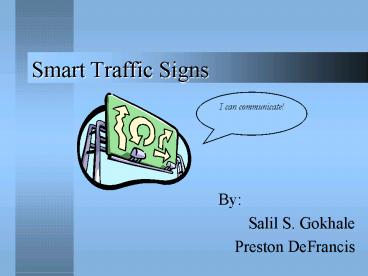Smart Traffic Signs - PowerPoint PPT Presentation
1 / 24
Title:
Smart Traffic Signs
Description:
Designing a Smart Traffic Sign. Software components for Modules: ... Provide antenna flexibility: Many types of antenna could provide directional transmission ... – PowerPoint PPT presentation
Number of Views:1680
Avg rating:3.0/5.0
Title: Smart Traffic Signs
1
Smart Traffic Signs
I can communicate!
- By
- Salil S. Gokhale
- Preston DeFrancis
2
Smart Traffic Signs
- Designing a Smart Traffic Sign
- Demonstrating a Working Prototype
- Enhancing the Concept
Think!
3
Designing a Smart Traffic Sign
General problem Road signs do not always convey
information effectively
- 1. Inclement weather
- 2. Poor or infrequent placement
- 3. Stolen for dorm room decoration
4
Designing a Smart Traffic Sign
- Interstate Traffic Sign Problem
Bridge Structure Interstate Signs Cost about
300,000!
5
Designing a Smart Traffic Sign
- Solution a Smart Traffic Sign
- Transmits information over a wireless link
- Replaces or augments traditional road signs
- Delivers information directly inside a motor
vehicle
6
Designing a Smart Traffic Sign
- Goal Deliver a prototype of a Smart Traffic Sign
that
- Uses a 433.9.2 MHz radio frequency link
- Operates on power supplies available in
cars(receiver) and near interstate signs
(transmitter) - Outputs information to driver on an illuminated
LCD screen
7
Designing a Smart Traffic Sign
- System-level architecture
Transmitter
Flash EEPROM
PIC on the modules
Stamp PIC
Receiver
Flash EEPROM
LCD display
PIC on the modules
Stamp PIC
Transmitter sends data serially to the receiver
8
Designing a Smart Traffic Sign
- Software components for Modules
Transmitter - Encodes information - Contains
Protocol Receiver - Decodes Information -
Contains protocol conversion program
- Includes LCD driver
9
Designing a Smart Traffic Sign
- Power Supplies
- Receiver Plugs into 12V DC supply of cars
cigarette lighter - Transmitter Uses 120 V AC supply of urban bridge
structure signs
10
Designing a Smart Traffic Sign
- Summary of Specifications
11
Demonstrating a Working Prototype
- Packaging the Modules
- Receiver Small, user-friendly package that
attaches with Velcro to cars
dashboard - Transmitter Weatherproof package enclosing
power supply and module
12
The First Car!
The 1995 Dodge Neon was the first car to have the
Smart Traffic Sign installed in it
13
Demonstrating a Working Prototype
- Testing the modules in heavy snow
Approximate distance of operation 300 ft.
14
Demonstrating a Working Prototype
- Testing the modules in clear weather
Approximate distance of operation 310 ft
15
Demonstrating a Working Prototype
- Conclusions for test
- Weather conditions do not significantly impair
performance - Current minimum range is enough to transmit 3072
characters at 9600 baud, more than enough for the
demonstration
16
Demonstrating a Prototype
17
Demonstrating a Prototype
- Summary of Prototype
- Transmitter and receiver housed in appropriate
packages - Field tests verified the meeting of project goals
- Demonstration validated the real-world operation
of the prototype
18
Enhancing the Concept
- A second generation prototype will
- Provide more range increased receiver
sensitivity allows better range from same
transmitter power - Decrease size of units new, smaller modules
could make units more attractive
19
Enhancing the Concept
- A second generation prototype will
- Use more sophisticated modulation improve
resistance to noise - Provide antenna flexibility Many types of
antenna could provide directional transmission
20
Enhancing a Concept
- Further Improvements
- Lane Specificity - provide lane-specific
information, perhaps using a buried antenna - User interface - Determine best method of getting
information to driver
21
Enhancing the Concept
Work has begun on the second generation model
22
Enhancing the Concept
- Summary of Recommendations
- Build a second-generation prototype for increased
performance - Develop a method of providing lane specific
information - Research most effective user interfaces
23
Acknowledgements
Professor Frank Merat, Project Technical
Advisor Professor Bob Gura, Project management
Advisor Professor Sreenath, Course Instructor
Dr. R.L. Mullen, Civil Engineering Advisor Brian
Leech Ted Square
24
Smart Traffic Signs
I can communicate!
Demonstration!































